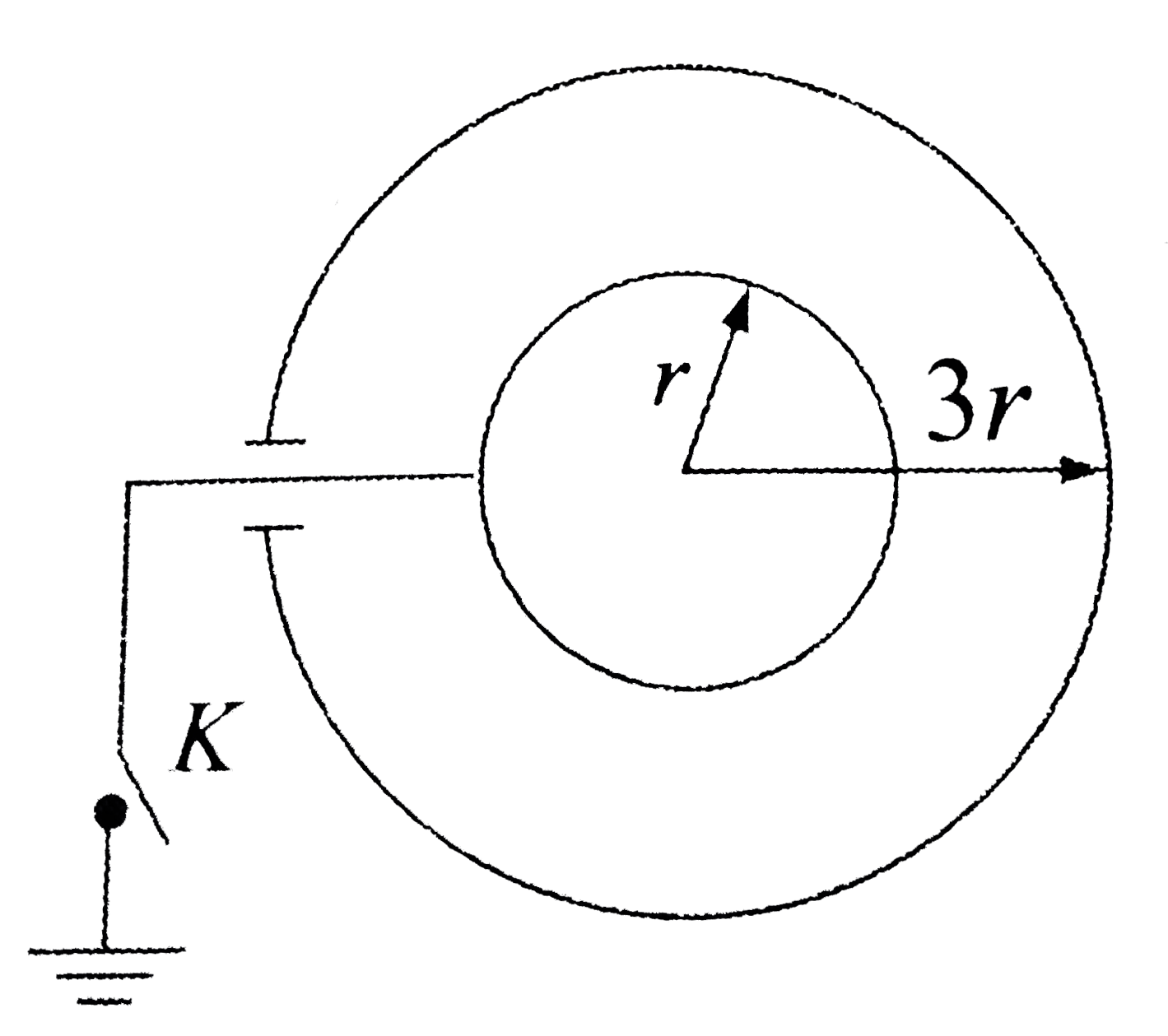Consider two concentric spherical metal shells of radii r1 and r2(r2>r1). If the outer shell has a charge q and the inner one is grounded, then the charge on the inner shell is
−r2r1q
zero
−r1r2q
−q
The correct Answer is:C
To solve the problem, we need to determine the charge on the inner spherical shell when the outer shell has a charge q and the inner shell is grounded. Here’s a step-by-step solution:
Step 1: Understand the setup
We have two concentric spherical shells:
- The inner shell (shell B) has a radius r1 and is grounded.
- The outer shell (shell A) has a radius r2 (where r2>r1) and has a charge q.
Step 2: Grounding condition
Since the inner shell is grounded, its electric potential VB must be zero.
Step 3: Calculate the potential at the inner shell
The potential V at a point due to a charged spherical shell is given by:
V=kQr
where k is the Coulomb's constant, Q is the charge, and r is the distance from the center.
The potential at the outer shell (shell A) due to its own charge q is:
VA=kqr2
Step 4: Consider the charge on the inner shell
Let Q′ be the charge on the inner shell (shell B). The potential at the inner shell due to its own charge is:
VB=kQ′r1
Step 5: Set up the equation for potential
Since the inner shell is grounded, we have:
VB+VA=0
Substituting the expressions for VA and VB:
kqr2+kQ′r1=0
Step 6: Solve for Q′
Rearranging the equation gives:
kQ′r1=−kqr2
Dividing both sides by k (which is non-zero) results in:
Q′r1=−qr2
Multiplying both sides by r1 gives:
Q′=−r1r2q
Conclusion
Thus, the charge on the inner shell is:
Q′=−r1r2q
Final Answer
The charge on the inner shell is −r1r2q.
---
We have two concentric spherical shells:
- The inner shell (shell B) has a radius r1 and is grounded.
- The outer shell (shell A) has a radius r2 (where r2>r1) and has a charge q.
Since the inner shell is grounded, its electric potential VB must be zero.
The potential V at a point due to a charged spherical shell is given by:
V=kQr
where k is the Coulomb's constant, Q is the charge, and r is the distance from the center.
VA=kqr2
Let Q′ be the charge on the inner shell (shell B). The potential at the inner shell due to its own charge is:
VB=kQ′r1
Since the inner shell is grounded, we have:
VB+VA=0
Substituting the expressions for VA and VB:
kqr2+kQ′r1=0
Rearranging the equation gives:
kQ′r1=−kqr2
Dividing both sides by k (which is non-zero) results in:
Q′r1=−qr2
Multiplying both sides by r1 gives:
Q′=−r1r2q
Thus, the charge on the inner shell is:
Q′=−r1r2q
The charge on the inner shell is −r1r2q.
Topper's Solved these Questions
- ELECTROSTATIC POTENTIAL AND CAPACITORSBOOK - DC PANDEY ENGLISHCHAPTER - ELECTROSTATIC POTENTIAL AND CAPACITORSEXERCISE - (B) Chapter exercises
17 Videos
- ELECTROMAGNETIC WAVESBOOK - DC PANDEY ENGLISHCHAPTER - ELECTROMAGNETIC WAVESEXERCISE - Sec C
22 Videos
- ELECTROSTATICSBOOK - DC PANDEY ENGLISHCHAPTER - ELECTROSTATICSEXERCISE - Medical entrances gallery
37 Videos
Similar Questions
There are two concentric metal shells of radii r1 and r2(>r1). If initially, the outer shell has a charge q and the inner shell is having zero charge and then inner shell is grounded. Find :
(i) Charge on the inner surface of outer shell.
(ii) Final charges on each sphere.
(iii) Charge flown through wire in the ground.
View SolutionThe capacitance of two concentric spherical shells of radii R1 and R2(R2>R1) is
View SolutionConsider two concentric spherical metal shells of radii 'a' and b>a .The outer shell has charge Q but the inner shell has no charge.Now the inner shell is grounded ,This means that the inner shell will come at zero potential and that electric fields lines leave the outer shell and end on the inner shell.(a) Find the charge on the inner shell
Find the potential on outer sphere.

View SolutionThe radii of two concentric spherical conducting shells are r1andr2(>r1). The change on the oute shell is q. The charge on the inner shell which is connected to the earth is
View SolutionThere are two concentric conducting spherical shells of radii 10cm and 20cm. The outer shell is charged to a potential of 50esu while inner shell is earthed. The charge on outer shell is
View SolutionFigure shows two conducting thin concentric shells of radii r and 3r. The outer shell carries charge q and the inner shell is neutral . The amount of charge that flows from the inner shell to the earth after the key K is closed is equal to (1/n)th of the charge on the outer shell. What is the value of n ?
 .
.
View SolutionThere are two concentric conducting spherical shells of radius rA and rB respectively (rB=2rA). If the inner shell is given a charge Q and outer shell is given a charge 2Q, then the potential difference between the surfaces of the shells will be K=14πε0
View SolutionCharge on the outer sphere is q, and the inner sphere is grounded. Then the charge q' on the inner sphere is q', for
(r2>r1)

View SolutionConsider two concentric metalic shell's of radii R and 2R. The inner shell is having charge Q and outer shell is uncharged. If they are connected with a conducting wire. Then,
View SolutionTwo concentric spherical shells of radius R1 and R2(R2>R1) are having uniformly distributed charges Q1 and Q2 respectively. Find out total energy of the system.

View Solution
